Isle of Thanet, Kent
Up to 1834
A parliamentary report of 1777 recorded parish workhouses in operation at: Thanet Minster (for up to 30 inmates), Ramsgate (84), St Lawrence (40), and Westgate—Holy Cross (30).
In 1794, Birchington formed a Gilbert Union with the parishes of Monkton, Sarre and Acole [contemporary spellings]. The union erected a poor-house a short distance from Birchington, on the road to Quex. The inmates worked at the manufacture of coarse sheeting and sacking. Between September 1822 and October 1825, the running of the workhouse was placed in the hands of a private contractor or 'farmer'. Edward Young was to be paid 2s.6d per week 'to victual. lodge, wash and clothe' the inmates and 'to find them every necessary (ye house, repairs of house, doctor and burying of dead excepted)'. The diet provided to the inmates is shown below. Presumably a ration of bread was also included.
| Breakfast | Dinner | Supper | |
| Sunday | Spoon Victuals | Meat | Spoon Victuals |
| Monday | Do. or Butter | Suet Pudding | Do. or Butter |
| Tuesday | " " | Meat | " " |
| Wednesday | " " | Suet Pudding | Do. occasionally |
| Thursday | " " | Meat | " " |
| Friday | Broth or Butter | Soup | Broth or Butter |
After 1834
The Isle of Thanet Poor Law Union officially came into existence on 20th April 1835. Its operation was overseen by an elected Board of Guardians, 13 in number, representing its 9 constituent parishes as listed below (figures in brackets indicate numbers of Guardians if more than one):
County of Kent:
Birchington including Gore's End, Minster (2), Monkton or Moncton, St Lawrence (2), St Nicholas at Wade (2), St Peter's (2), Sarr [Sarre], Stonar, Wood or Acol.
Later Additions: Garlinge (from 1894), Northdown (from 1894), Margate—St John the Baptist (from 1836), Ramsgate (from 1836), Westgate on Sea (from 1894).
The population falling within the Union at the 1831 census had been 7,474 — with parishes ranging in size from from Stonar (population 52) to St Peter's (2,342). The average annual poor-rate expenditure for the period 1831-4 had been £7,688 or £1.0s.7d. per head of the population.
Initially, the Guardians' meetings were held at the Prospect Inn. They quickly purchase 2½ acres of land at Minster on which to build the Isle of Thanet Union workhouse. The establishment, which was opened in 1836, was designed by Assistant Poor Law Commissioner, Sir Francis Head, using the "courtyard" plan the he had originated. This type of layout, in which an outer perimeter of buildings enclosed a large inner courtyard, was employed by a number of Kent Unions including Blean, Bridge, Eastry, East Ashford, Faversham and Maidstone. The Poor Law Commissioners authorised an expenditure of £6,583 on construction of the building which was to accommodate 400 inmates. The workhouse location and layout are shown on the 1907 map below.
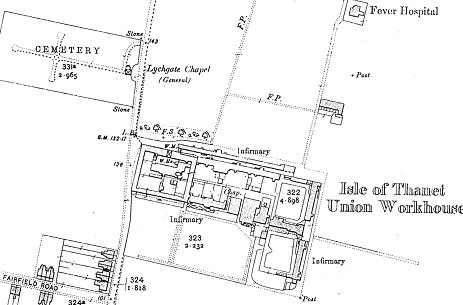
Thanet site, 1907.
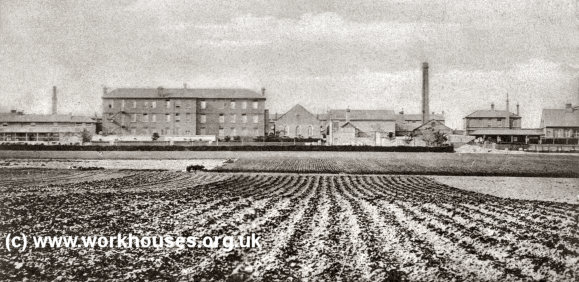
Thanet workhouse from the south, early 1900s.
© Peter Higginbotham.
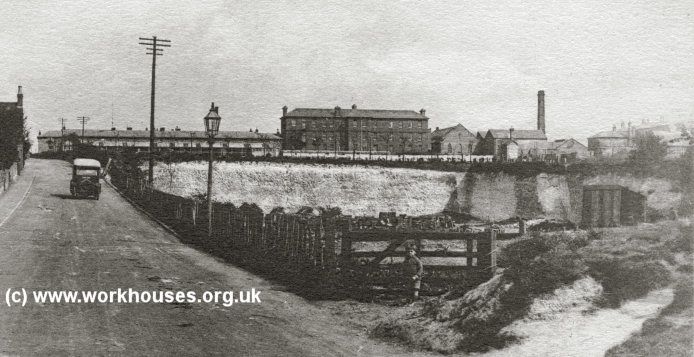
Thanet workhouse from the south, early 1900s.
© Peter Higginbotham.
Between 1915 and 1920, the workhouse temporarily became Hill House Military Hospital. After 1930, following the abolition of the workhouse system, the workhouse became Hill House Public Assistance Institution.
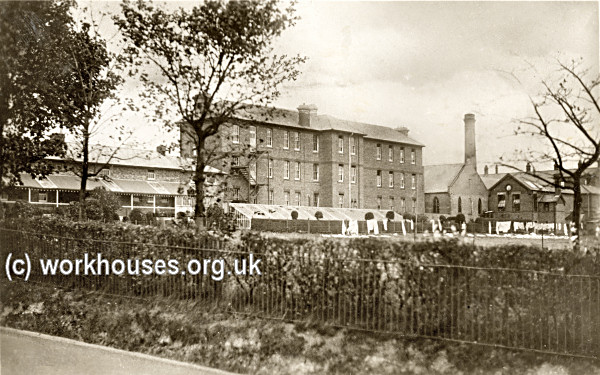
Hill House from the south-west, 1930s?
© Peter Higginbotham.
In 1948, premises were taken over by the National Health Service under the name of Hill House Hospital. The hospital closed in 1986 and the buildings were demolished in 1989. A housing estate now stands on the site.
Manston Cottage Homes
In 1901, the Isle of Thanet Union opened a children's home at Manston (or Manstone).
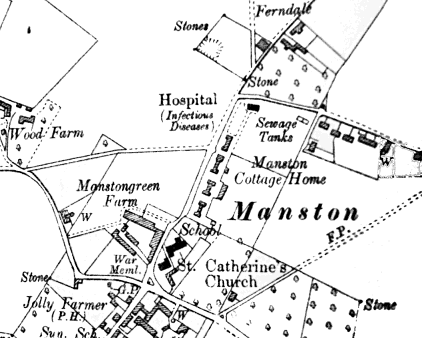
Manston Cottage Homes site, 1936.
The homes comprised four pairs of houses and could accommodate a total of 120 children.
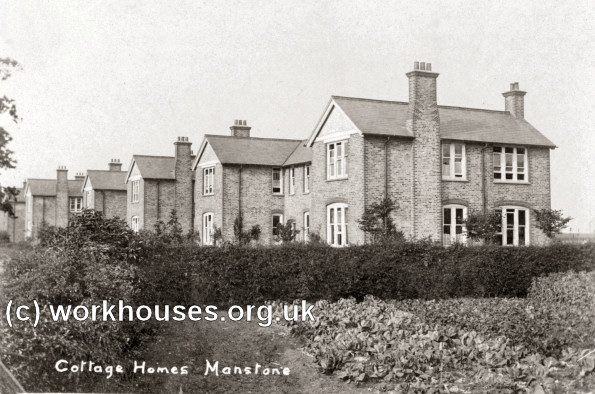
Manston Cottage Homes from the south-west, c.1905.
© Peter Higginbotham.
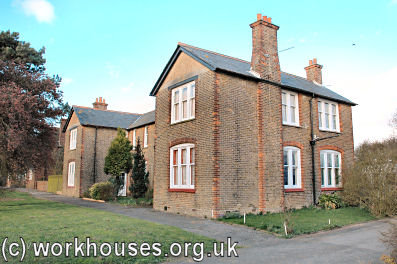
Manston Cottage Homes from the south-west, 2005.
© Peter Higginbotham.
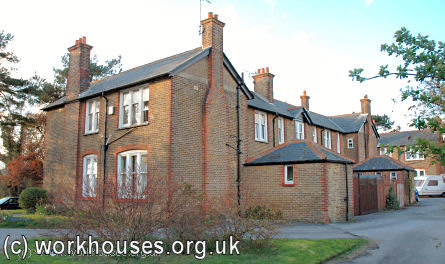
Manston Cottage Homes from the south-east, 2005.
© Peter Higginbotham.
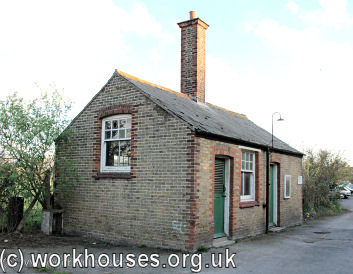
Manston Cottage Homes, 2005.
© Peter Higginbotham.
The homes have now been converted to residential use.
Staff
Inmates
Records
Note: many repositories impose a closure period of up to 100 years for records identifying individuals. Before travelling a long distance, always check that the records you want to consult will be available.
-
Kent History and Library Centre, James Whatman Way, Maidstone, Kent (from Spring 2012).
Very extensive records survive:
- General union records including: Guardians' minutes (1835-1930); Ledgers (1835-1930, with gaps); Register of deserted children (1890-1931); Emigration register 1887-94; etc.
- Workhouse records including: Births and baptisms (1848-66, 1905-29); Deaths (1866-1931); Creed register (1905-30); Admissions and discharges (1872-1930); Inmates' complaints (1895-1909); Punishment book (1895-1914); Casuals admission register (1910-29); etc.
- Cottage Homes records including: Admissions and discharges (1901-29); Creed register (1901-28); etc.
- Canterbury Cathedral Archives, The Precincts, Canterbury, Kent CT1 2EH.
Bibliography
- Higginbotham, Peter Workhouses of London and the South East (2019)
- Gilham, Joyce (1991) The Isle of Thanet Union Workhouse (Thanet District Council)
Links
- None.
Unless otherwise indicated, this page () is copyright Peter Higginbotham. Contents may not be reproduced without permission.


